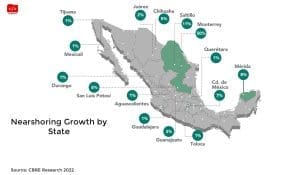
Mexico is the second-largest economy in Latin America. It is a country of 126 million with a GDP of 1.273 trillion— behind Brazil’s 1.609 trillion. In recent years, nearshoring in Mexico has grown due to the rise of remote work, improved infrastructure, and friendly trade agreements.
In the last decade, the Mexican economy has seen a steady yearly growth of 2.1 percent on average. According to the Federal Reserve of Dallas, Mexico’s 2022 fourth-quarter GDP rose 1.6%. Although this is slower than previous quarters, it still maintains an increase. Like other countries, Mexico suffered inflation and economic slowdown- as a result of pandemic and post-pandemic circumstances, policies, and adjustments. This is also the case in the U.S. Nevertheless, the country’s economy held on as one of the most stable countries in LATAM.
As reported in our Mexico Tech Salaries Report 2023 IT salary guide, many U.S. companies expanded to Mexico and Latin America because of the many advantages the region offers over other outsourcing destinations. Companies like
Mexico’s Growth Due to Nearshoring
At this point, it’s no secret that Mexico has become a sought-after destination for nearshoring. Covid exposed the fragility of many supply chains. Businesses began thinking twice about depending on outside players that were many miles and time zones away.
These vulnerabilities are particularly true with ongoing tensions between the U.S. and China, which have led many U.S. companies to invest in massive relocation efforts to a location that is not only in friendlier territories but closer geographically.
So while Mexico has had uncertainties and complications in the last few years, it has managed to capture the attention of American companies as a nearshoring destination poised for growth. Several internal characteristics have helped its position: increased investment in technology and tech infrastructure, increased entrepreneurial activity, friendly business policies, trade agreements, and more. The states with the most concentration of growth due to nearshoring include:
- Nuevo Leon -50%
- Coahuila – Coahuila 11%
- Yucatan – 8%
- Mexico City -7%
- San Luis Potosi – 6%

One of the keys to nearshoring’s success is proximity: both geographic and cultural. Mexico is not only one short flight away from most major cities in the United States, but it is also far more culturally aligned to the U.S. than any other country in Asia, putting it at an advantage.
In addition, there is an ethical component to doing business with China that emerged to the forefront much more prominently in recent years. For many companies, China’s ethical baggage has obstructed their comfort in doing business with the country.
Nearshoring Growth Goes Beyond Manufacturing
At first glance, it may seem that the bulk of nearshoring’s growth in Mexico is relegated mostly to the manufacturing sector. While it is true that manufacturing is a big aspect of nearshoring, other industries have also seen benefits and growth from increased outside investment and hiring.
Nearshoring to Mexico and the Manufacturing Industry
In early 2023, for example, Tesla announced that they’d be building a Tesla Gigafactory in the state of Nuevo Leon in Mexico. According to reports, the factory will be bigger than the one located in Texas and will be worth up to five billion dollars- making it the world’s biggest electric vehicle plant to date. The automotive industry is certainly one of the main benefactors of these friendly trade agreements and nearshoring capabilities. Other companies like General Motors, Ford, BMW and Volkswagen Audio are all producing electric vehicles south of the U.S. border.
Nearshoring to Mexico and the Tech Industry
The services industry has also seen considerable growth throughout Mexico in recent years. Not only has Mexico increased the number of unicorns formed, seen increased VC investment, and fostered entrepreneurial energy in pockets of the country, it has also heavily invested in education. When it comes to technology, Mexico emphasized educating and training a new generation of developers, engineers, and other tech professionals. This investment has paid dividends, as many young professionals find themselves in an advantageous position to connect with U.S. companies looking to expand or cut costs in a new market.
Learn More About Hiring Tech Professionals in Mexico
There are many advantages of outsourcing software development or hiring a remote team in Mexico, and they go far beyond costs. Companies are learning that the LATAM market has unique characteristics that make for building effective and powerful remote tech teams. Mexico’s tech ecosystem has a competitive edge over the rest of LATAM.
Don’t miss out on the great opportunity to add some of the world’s best talent to your ranks. Talk to one of our experts on the ground.


